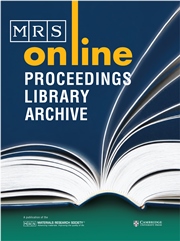Article contents
Time Resolved Electroluminescence in a-Si:H p-i-n Junctions
Published online by Cambridge University Press: 25 February 2011
Abstract
Time resolved and steady state electrololuminescence (EL) measurements have been performed in a-Si:H p-i-n junctions at 10K < T < 300K in order to study the recombination in these devices. At low temperatures the rise of the EL following a rectangular forward current pulse consists of a fast component with a time constant of a few μs and a slow component with a time constant of about a ms. The data suggest that the time response of the EL is determined not only by the recombination but also by the time to build up the carrier density for bimolecular radiative recombination. The fast component of the EL is attributed to the field enhanced recombination of carriers which survived from the preceding pulse. Steady state measurements reveal characteristics of bimolecular recombination. The EL spectrum is shifted by 50meV to lower energies with respect to the photoluminescence spectrum.
Information
- Type
- Research Article
- Information
- Copyright
- Copyright © Materials Research Society 1990
References
REFERENCES
- 6
- Cited by

